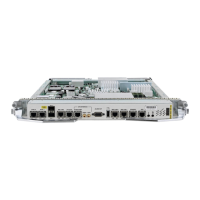Restrictions for PIM-SM and PIM-SSM, and PIM BIDIR
Interoperability with SSM
PIM-SM operations within the SSM range of addresses change to PIM-SSM. In this mode, only PIM (S,G)
join and prune messages are generated by the router, and no (S,G) RP shared tree or (*,G) shared tree messages
are generated.
IGMP Version
To report multicast memberships to neighboring multicast routers, hosts use IGMP, and all routers on the
subnet must be configured with the same version of IGMP.
A router running Cisco IOS XR Software does not automatically detect Version 1 systems. You must use the
version command in router IGMP configuration submode to configure the IGMP version.
PIM-Bidir Restrictions
PIM-Bidir is not supported on MVPN.
Internet Group Management Protocol
Cisco IOS XR Software provides support for Internet Group Management Protocol (IGMP) over IPv4.
IGMP provides a means for hosts to indicate which multicast traffic they are interested in and for routers to
control and limit the flow of multicast traffic throughout the network. Routers build state by means of IGMP
and MLD messages; that is, router queries and host reports.
A set of queries and hosts that receive multicast data streams from the same source is called a multicast group.
Hosts use IGMP and MLD messages to join and leave multicast groups.
IGMP messages use group addresses, which are Class D IP addresses. The high-order four bits of a Class D
address are 1110. Host group addresses can be in the range 224.0.0.0 to 239.255.255.255. The address
224.0.0.0 is guaranteed not to be assigned to any group. The address 224.0.0.1 is assigned to all systems
on a subnet. The address 224.0.0.2 is assigned to all routers on a subnet.
Note
IGMP Versions
The following points describe IGMP versions 1, 2, and 3:
•
IGMP Version 1 provides for the basic query-response mechanism that allows the multicast router to
determine which multicast groups are active and for other processes that enable hosts to join and leave
a multicast group.
•
IGMP Version 2 extends IGMP allowing such features as the IGMP query timeout and the maximum
query-response time. See RFC 2236.
•
IGMP Version 3 permits joins and leaves for certain source and group pairs instead of requesting traffic
from all sources in the multicast group.
Cisco ASR 9000 Series Aggregation Services Router Multicast Configuration Guide, Release 5.1.x
7
Implementing Layer-3 Multicast Routing on Cisco IOS XR Software
Internet Group Management Protocol

